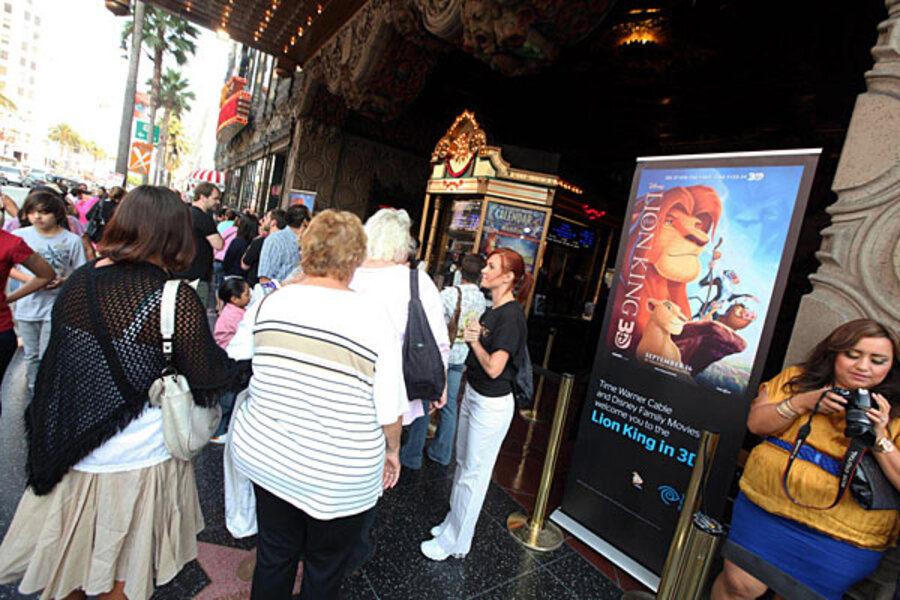'Lion King' success: Should Hollywood fall back in love with 3D?
Loading...
| Los Angeles
Now that “The Lion King 3D” has ruled the box office two weekends in a row – topping Brad Pitt in “Moneyball” – Hollywood studios are bullish on the format once more.
Once-tentative plans are being firmed up to convert everything from the six “Star War” films to “Titanic,” “Lord of the Rings,” and “Top Gun.”
One of the biggest advocates of 3D filmmaking, “Avatar” director James Cameron, was quoted as saying at a recent conference that within five years, every film would be in 3D.
Not so fast, say a range of analysts, moviegoers and academics. While 3D may have helped propel the film’s winning streak, it is not a silver bullet.
“After ‘Avatar’ did so well, everyone thought that 3D was where filmmaking was going,” says Paul Degarabedian, box office analyst for Hollywood.com. But then, 3D took a beating at the box office after a number of films such as “Clash of the Titans,” did poorly and were critically drubbed for a poor 3D conversion.
Other observers say Hollywood should be careful not to take the wrong lesson from the triumph of a returning modern classic to the big screen.
“As a parent, I can tell you why ‘The Lion King’ beat ‘Moneyball’ at the box office,” says public relations expert Sandi Straetker via email.
“EVERYONE can enjoy ‘The Lion King,’ ” she says. “I can go with my kids and their grandparents and enjoy a wonderful, universally appealing story, beautifully told on the big screen.” She says she owns the DVD, which her two children, ages 10 and 12, have seen many times. The family has also seen the staged version of the musical.
Many who have continued to view 3D as a passing gimmick – yet again – suggest that Hollywood should stop looking for a cure-all.
The 3D format has been around for a long time, points out “New New Media” author Paul Levinson, a professor at Fordham University in New York. It was a big trend in the 1950s, he says, but it died out because it is “basically a gimmick, not essential to the storytelling of filmmaking.” Each time 3D makes a splash, “everyone thinks it’s the savior of the film industry.”
Audiences are tired of paying the extra ticket charge for so-called blockbusters pumped up with often dim, poorly-projected 3D, says Seton Hall University film professor Christopher Sharrett.
Ticket sales for the latest 3D installments of “Harry Potter” and “Pirates of the Caribbean” were far weaker than expected; the 2D editions did better, he points out, adding that sales of 3D televisions have hardly produced the windfall that the electronics industry expected.
The 3D format has often been used to boost poor, uninspired movies, he says, adding, “3D might be put back on the shelf for another 20 years, until its gimmick value seems fresh again.”
But Ms. Straetker says she would pay the extra charge to see “The Lion King” in 3D, “because I do think it would be a unique experience,” nonetheless, adding, “I think there is more to this success than just the 3D aspect of it. I think that there is a market for good, classic, family-friendly films.”
In today’s crowded marketplace, even beloved classics need every ounce of help they can get to break through, says Rob Hummel, president of Legend3D, a leading 3D conversion company based in San Diego which has done 2D-to-3D conversion work on “Transformers: Dark Side of the Moon,” “The Smurfs,” “Green Lantern,” “Alice in Wonderland,” all the “Shrek” films and are currently working on a 3D theatrical release of “Top Gun.”
He notes that a re-release 15 years ago of “Mary Poppins,” “a personal favorite,” quietly died at the box office, because there was nothing special to draw attention to it. He acknowledges there have been dismal failures, both in the conversion process as well as new films. But, he adds, “when the conversion is done right, the films can really sparkle.”
He says it is extremely helpful to work alongside the original filmmakers, as is being done with such modern classics as the “Star Wars” franchise as well as James Cameron’s “Titanic.”
The director himself is overseeing the conversion, which will consume a year at a cost of some $18 million. Lest anyone doubt the painstaking nature of the work, Mr. Cameron was quoted as saying the process is akin to “mowing the lawn with a nail clipper.”





